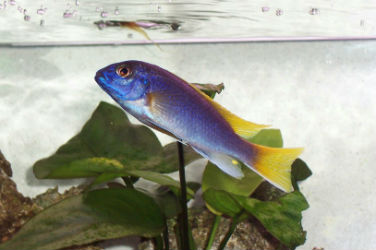|
Affiliate Disclaimer : We
work to provide tropical fish information and locate merchants who sell the products
you are looking for. If you make a purchase from any of the merchants we endorse, we
will earn a small commission at no additional cost to you. Thank you for your support!
Home > Acei Cichlid | Everything you ever wanted to know about the Acei cichlid

Acei Cichlid | Everything you ever wanted to know about the Acei cichlid

 The acei cichlid has a very diverse family with at least 1,300 to 3,000 species which makes it one of the biggest vertebrate families. They exhibit many different body shapes however, most are medium-sized, slightly laterally compressed and ovate in shape.
They all share one familiar trait being the way the lower pharyngeal bones are fused into one tooth bearing structure. A very complex set of muscles helps the lower and upper pharyngeal bones to act as a second jaw to process food.
The acei cichlid is a very efficient feeder that can process a wide variety of food. They are a unique species that boasts only the presence of one nostril, instead of two on each side of their forehead and their eyes do not have a bony shelf below the orbit. Additionally, their small intestines exit on the left side rather than on the right side as in most other fish species.
Diet
Most of the acei cichlid are primarily herbivores that feed mainly on algae and plants, although, there are some that will feed on small invertebrates. Others are predatory and barely eat any plant matter at all and fill their diet with small animals, fish and an abundance of insect larvae.
Some species are considered pursuit predators, chasing down their prey in open water while others have death-mimicking techniques where they lay completely motionless and “play dead” until small fish are lured to their side and then they ambush them.
Types Of Brooding
All species of the acei cichlid will care for the eggs and the larvae and often extend their guidance until the young are months old. Several species also use a skin secretion from their mucous glands to feed their young. Parental care generally falls into four different categories being open brooders, cave brooders, ovophile mouthbrooders and larvophile mouthbrooders.
Cave Brooding
The secretive acei cichlid will lay their eggs in crevices, holes and caves, often attaching the eggs at the roof of the chamber. Parents will communicate with their free-swimming fry with various body movements. Both parents who are cave brooders help to find food for their fry.
Open Brooding
These cichlids will lay their eggs out in the open on leaves, rocks and logs. The female and male parents engage in different brooding roles. The male will patrol the territory and repel away intruders while the female watches over the eggs and removes the infertile ones while the fry is foraging.
Larvophile Mouthbrooding
This type of acei cichlid will lay its eggs either in a cave or out in the open and then take the hatched larvae away in its mouth. The mouthbrooder is usually the female.
Ovophile Mouthbrooding
These mouthbrooders incubate their eggs within their mouths once they are laid. Additionally, they will mouthbrood their free-swimming fry for a few weeks.
Aquarium
Many acei cichlids have become extremely popular as aquarium fish since 1945. Since many are medium-sized or smaller, they are suited well for aquarium life. They will happily feed on a wide range of food and they will breed and practice brooding in captivity. The most common aquarium species are the angelfish and Oscar. Most cichlids can live in harmony with other fish but on occasion, they may eat those that are smaller than they are.
Hybrids
Numerous species in the acei cichlid family have been selectively bred as ornamental aquarium fish. Both recessive and dominant pigment mutations have been recorded. Selective breeding is not without its unintentional consequences and some intentional inbreeding will often result in physical abnormalities.

|


